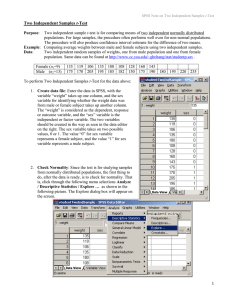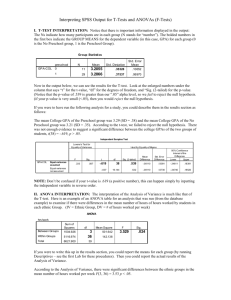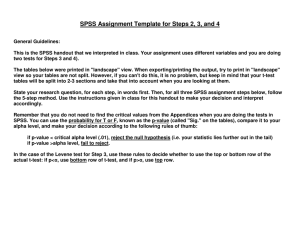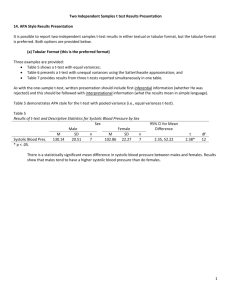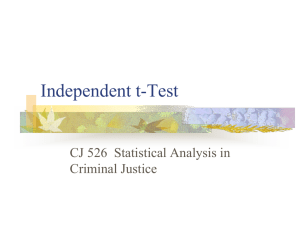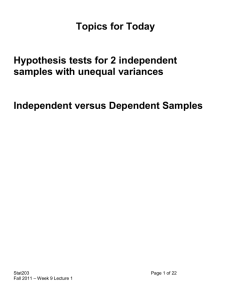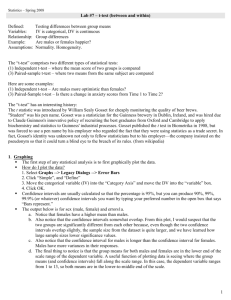Week 6 Mean testing: T.Test READING Text reading Dancey and
advertisement
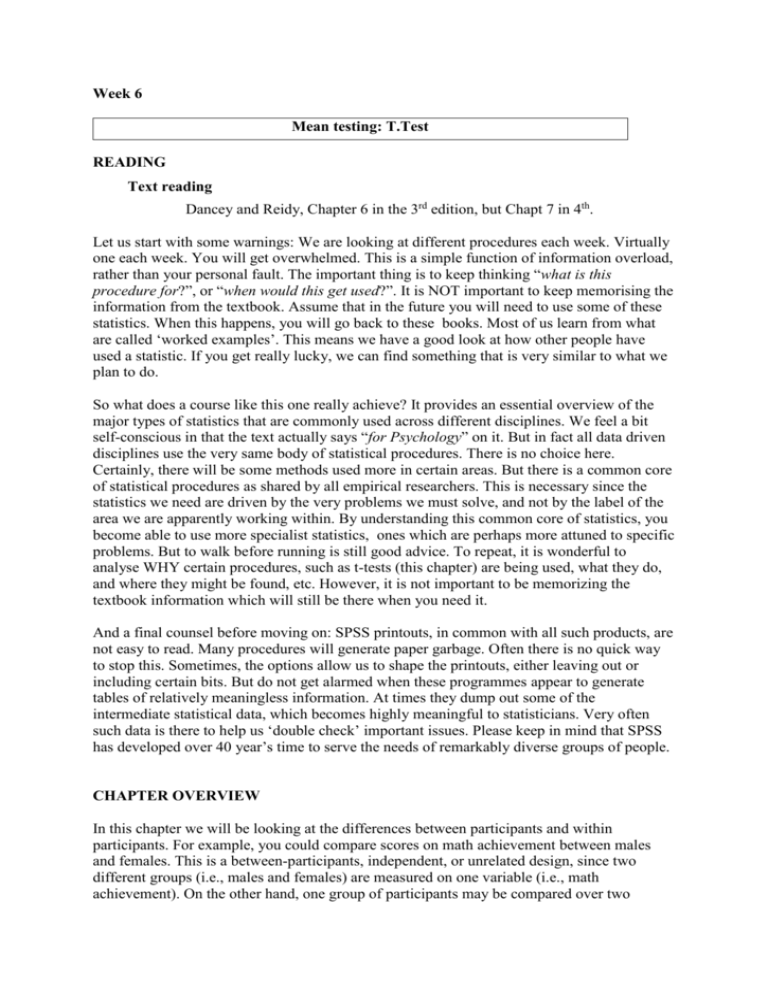
Week 6 Mean testing: T.Test READING Text reading Dancey and Reidy, Chapter 6 in the 3rd edition, but Chapt 7 in 4th. Let us start with some warnings: We are looking at different procedures each week. Virtually one each week. You will get overwhelmed. This is a simple function of information overload, rather than your personal fault. The important thing is to keep thinking “what is this procedure for?”, or “when would this get used?”. It is NOT important to keep memorising the information from the textbook. Assume that in the future you will need to use some of these statistics. When this happens, you will go back to these books. Most of us learn from what are called ‘worked examples’. This means we have a good look at how other people have used a statistic. If you get really lucky, we can find something that is very similar to what we plan to do. So what does a course like this one really achieve? It provides an essential overview of the major types of statistics that are commonly used across different disciplines. We feel a bit self-conscious in that the text actually says “for Psychology” on it. But in fact all data driven disciplines use the very same body of statistical procedures. There is no choice here. Certainly, there will be some methods used more in certain areas. But there is a common core of statistical procedures as shared by all empirical researchers. This is necessary since the statistics we need are driven by the very problems we must solve, and not by the label of the area we are apparently working within. By understanding this common core of statistics, you become able to use more specialist statistics, ones which are perhaps more attuned to specific problems. But to walk before running is still good advice. To repeat, it is wonderful to analyse WHY certain procedures, such as t-tests (this chapter) are being used, what they do, and where they might be found, etc. However, it is not important to be memorizing the textbook information which will still be there when you need it. And a final counsel before moving on: SPSS printouts, in common with all such products, are not easy to read. Many procedures will generate paper garbage. Often there is no quick way to stop this. Sometimes, the options allow us to shape the printouts, either leaving out or including certain bits. But do not get alarmed when these programmes appear to generate tables of relatively meaningless information. At times they dump out some of the intermediate statistical data, which becomes highly meaningful to statisticians. Very often such data is there to help us ‘double check’ important issues. Please keep in mind that SPSS has developed over 40 year’s time to serve the needs of remarkably diverse groups of people. CHAPTER OVERVIEW In this chapter we will be looking at the differences between participants and within participants. For example, you could compare scores on math achievement between males and females. This is a between-participants, independent, or unrelated design, since two different groups (i.e., males and females) are measured on one variable (i.e., math achievement). On the other hand, one group of participants may be compared over two variables (i.e., before and after treatment). This is a within-participants, repeated measures, or related design, because the same people are measured on both variables (i.e., math and science). T. test statistic is used to compare means between participants or within participants. In this chapter we are going to show you how to analyse the data from such designs. To enable you to understand the tests presented in this chapter, you will need to have an understanding of the following concepts: the mean, standard deviation, and standard error (Chapter 2) z-scores and the normal distribution (Chapter 3) assumptions underlying the use of parametric tests (Chapter 4) probability distributions like the t-distribution (Chapter 4) one- and two-tailed hypotheses (Chapter 4) statistical significance (Chapter 4) confidence intervals (Chapter 3). KEY TERMS 1- Independent sample t-tests 2- Paired sample t-tests 3- Cohen effect size (d) 4- Leven tests of homogeneity of variance KEY POINTS 1- Independent sample t-test is used to compare the means of two independently sampled groups (between-participants design) over one variable/condition. For example, do students who attend school regularly differ in their academic achievement from students who attend school irregularly? 2- Dependent sample t-test is used to compare the means of one sample group over two variables/conditions. For example, does students’ mathematics achievement differs before and after a math anxiety remediation program? Further readings T-test http://www.socialresearchmethods.net/kb/stat_t.htm Independent T-test http://www.ruf.rice.edu/~bioslabs/tools/stats/ttest.html Dependent T-test class.unl.edu/psycrs/handcomp/hcwgt.PDF http://www- 3- Cohen’s effect size shows the magnitude of difference between two independent means, expressed in standard deviations. Cohen’s d can be calculated from this x1 x 2 formula d meanSD Where x1 is the mean for the first group and x2 is the mean for the second group, and meanSD is the mean standard deviation of the two groups. Further readings What is effect size? http://davidmlane.com/hyperstat/effect_size.html What is an 'Effect Size'? A Downloadable PDF guide for users http://davidmlane.com/hyperstat/effect_size.html Interactive tool to calculate effect size http://web.uccs.edu/lbecker/Psy590/escalc3.htm Effect Size Calculator (Excel sheet downloadable version) http://davidmlane.com/hyperstat/effect_size.html 4- Levene’s test of homogeneity of variance tests the assumption that the variance in each group or category of the independent variable is the same. Therefore if Levene’s test is significant at p < .05 then we can conclude that the null hypothesis is incorrect and that the variances are significantly different, therefore, the assumption of homogeneity of variance has been violated. If, however, Levene’s test is not significant at p > .05, then we accept the null hypothesis that the assumption of homogeneity of variance is tenable. SPSS activities 1- Independent T-test http://distdell4.ad.stat.tamu.edu/spss_1/TwoSampleTTest.html 2- Paired sample T-test http://distdell4.ad.stat.tamu.edu/spss_1/PairedTtest.html ACTIVE LEARNING AND OPPORTUNITIES Multiple Choice Questions 1- The DF for independent samples t-test analysis with 20 participants in each group is: ABCD- 38 20 40 68 2- The most important assumption to meet when using a t-test is ABCD- The variation in scores should be minimal Scores should be drawn from a normally distributed distribution Conditions should have equal means All of the above 3- In an analysis using independent t-test, you find the following result Levene’s test for equality of variance: F = .15, p = .58 This result show the variances of the two groups are: A- Dissimilar B- Similar C- Exactly the same D- Indeterminate Questions 4 to 8 relate to the tables of results Group Statistics math achieve Gender 0 1 N 254 192 Mean 19.30 16.68 Std. Deviation 4.123 5.443 Std. Error Mean .259 .393 Independent Samples Test Levene's Tes t for Equality of Variances F Math achieve Equal variances ass umed Equal variances not as sumed 28.413 Sig. .000 t-tes t for Equality of Means t df Sig. (2-tailed) Mean Difference Std. Error Difference 95% Confidence Interval of the Difference Lower Upper 5.769 444 .000 2.61 .453 1.723 3.503 5.555 343.770 .000 2.61 .470 1.688 3.538 4- Are the variances of math achievement homogenous in males and females? 5- Are there any significant differences between males and females in math Explain? achievement? 6- Who achieved higher in math; males or females? 7- What does the confidence interval of the mean difference tell? 8- Calculate the effect size for the math achievement mean difference between males and females.

